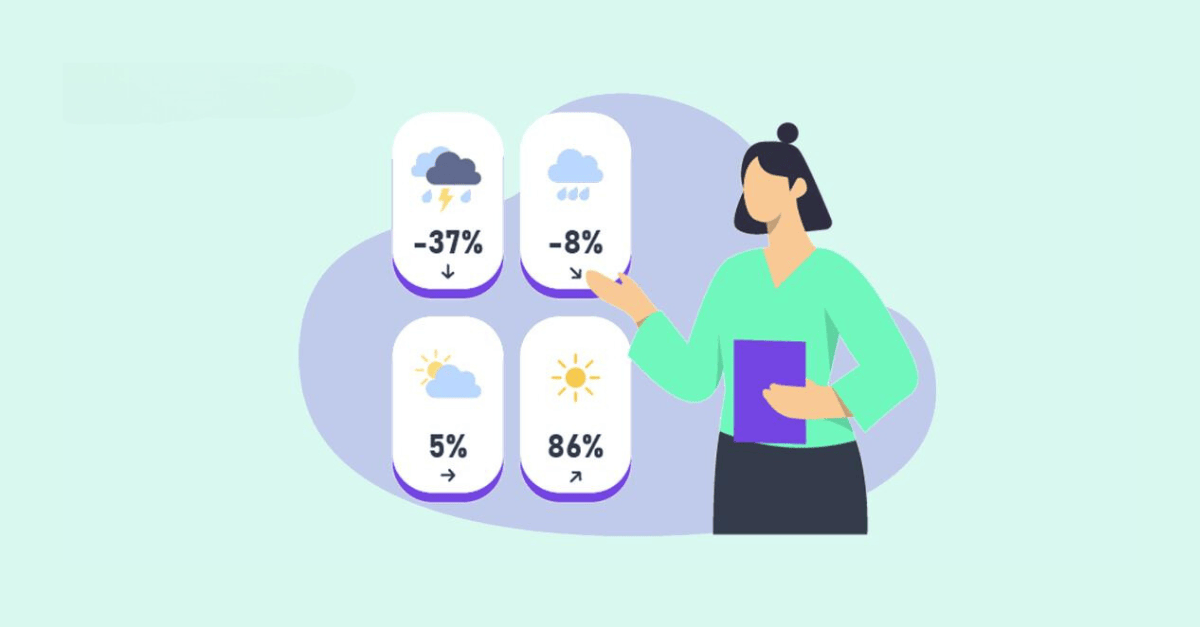How to build a great forecast: Key startup metrics and techniques
At Forecastr, we know that forecasting metrics is an essential part of running a successful startup. Accurately forecasting your startup's growth and...
7 min read
 Jeff Erickson
November 6, 2023
Jeff Erickson
November 6, 2023
Running a startup or a small business can feel like sailing through uncharted waters when you’re managing finances. As a founder, keeping your ship afloat is your top priority. But to do that, you need to understand the metrics and nuances that determine whether you will sink, when, and how tumultuous the seas can become before it happens.
Revenue forecasting is one of the most vital tools at your disposal. It is your compass, enabling strategic decision-making, efficient resource allocation, and instilling investor confidence and your financial model is your map.
Embracing revenue forecasting empowers startups and small businesses with the foresight necessary to navigate challenges adeptly, capitalize on opportunities, and translate aspirations into tangible achievements. In this post, we will explore the reasons why they are so important and the methods you can use to master them.
Key takeaways:
Strategic pivots with insight: Leverage revenue forecasts to recognize the need for change, reallocate resources efficiently, communicate with stakeholders effectively, and measure the success of strategic pivots, ensuring adaptability and growth.
Charting a clear financial course: Revenue forecasting isn't just about prediction; it's about preparation. By adopting best practices, businesses can navigate uncertainty, identify opportunities, leverage technology and human insights, and remain adaptable and forward-thinking for sustainable growth and success.

An accurate and well-constructed revenue forecast gives you insight and perspective when you’re making decisions that will impact your company’s future direction and funding. We’ll highlight a few advantages you gain with a good forecast.
Revenue forecasting amps up your ability to make informed decisions across all aspects of your business. Whether you’re making operational adjustments, planning new marketing strategies, or forecasting your cash flow and runway - your revenue forecast provides valuable perspective about your financial future.
Operational adjustments
Knowing your future revenue can help you make smart operational tweaks. If you're expecting a boost in income because of a new product release or a seasonal rush, you can gear up by hiring extra help, stocking up on inventory, and ramping up resources. On the flip side, if things are looking slow, it's a good time to start thinking about cost-cutting strategies to keep things on track.
Marketing and sales initiatives
Your revenue forecast allows you to fine-tune your marketing and sales plans practically. If the numbers suggest you might fall short, you can proactively step up your marketing efforts or promote some special deals. If a rival is exiting the scene, or you’re anticipating a lucrative new partnership, you can adjust your strategy to take advantage of the opportunity.
Cash flow management
Cash flow is the heartbeat of your startup. When you can predict how much money is coming in, you can adjust your expenses to make sure you always have enough cash on hand to cover bills, salaries, and everything else. This keeps things running smoothly and makes everyone involved feel more confident in your leadership.
For startups and SMBs, earning investor trust is a big deal. Here’s how a great revenue forecast can help:
Transparency
When you provide potential investors with a well-prepared, realistic revenue forecast, you give them a clear understanding of where your company's finances are headed. It shows that you've put in the effort to understand the market and have a good handle on how your business fits in.
Risk mitigation
Investors are always weighing the rewards against the risks. When you present a strong forecast supported by real data, it shows that you're doing your best to minimize those risks for them. It demonstrates forward-thinking and indicates that your startup will be prepared to tackle unexpected market shifts, which gives potential investors warm fuzzies.
Gauging ROI
A thorough revenue forecast gives investors a clear idea about when they might start seeing a return on their investment. Knowing when a company is expected to cover its costs and become profitable helps them understand the potential return on their investment so they can determine whether or not it matches their financial objectives.
In the small business scene, change is a constant. Knowing when and how to pivot is a fundamental skill for a founder to have. Instincts and hunches are part of that skill, but harnessing data-driven insights is what sets the pros apart from the greenhorns.
Recognizing the need for change
When you constantly keep a close eye on your forecast, you’re quick to pick up on trends in your business. If a product or service consistently falls short of its expected revenue or if there's a continuous drop in growth, you get a clear signal that it’s time to make a change.
Reallocating resources
When you change your focus, you’ll probably need to move some things around, like money, people, or tech. Knowing your revenue projections for different post-pivot scenarios can help you make smart choices about where and how to use your existing resources most effectively.
Stakeholder communication
Your investors, your team, and your partners; it's important to keep them all in the loop about big changes. A solid forecast helps you communicate data-driven reasons for the new direction, so you can simply explain why you're making the change and what you expect to happen as a result.
Measuring success
After you make a pivot, it's crucial to understand how the change is impacting your revenue. By comparing your real earnings to your forecast, you can figure out if the pivot is doing the trick. If it's going well, that's fantastic. If not, your forecast can point you in the right direction to make the necessary tweaks.

In the dynamic world of small business, the ability to make smart decisions, raise capital, and plan for the future can spell the difference between blowing up and burning out. A good revenue forecast lets you do all those things well.
So how do you do it? Here are the best practices you need to know to make sure your forecast always keeps you pointed in the right direction.
As a startup or an SMB, you probably don’t have access to endless loads of vast data like the big players. But that's okay. It can actually work in your favor.
Start by focusing on your core revenue streams, and then gradually add in the smaller sources. A phased approach like this makes it easier for you to learn the ropes while making sure your decisions are based on the most impactful data.
Your past performance data is like a treasure chest when it comes to forecasting future trends. If you're just starting and don't have much data to draw from, take a peek at industry averages for businesses like yours. Starting from a realistic baseline makes it easier to identify patterns and set achievable goals.
If you’re at the helm of a startup or small business, you’re almost certainly an optimistic person. When you’re fired up about the potential of a new business, it’s easy to get carried away with overly optimistic forecasts. However, it’s wise to take a cautious approach in your base forecast.
A more conservative forecast helps you avoid overcommitting resources and disappointing stakeholders. As a general rule, optimism is good; but realism is essential.
If you can’t help yourself, create an alternate “Best Case Scenario” and reach for the stars in a forecast that you don’t share with your investors and board members.
Predictions can become outdated quickly if they aren’t updated with your actual performance. You know how quickly the market and technology shift, and you need to make sure your forecast keeps up with those changes. Following a regular monthly routine makes your forecasts more accurate, and makes you better at using them.
Some businesses, especially retail and tourism, have obvious ups and downs throughout the year. Others, like some B2B offerings, have more subtle and nuanced trends.
When you create your forecast, account for busy seasons and slow months so you can manage resources, inventory, hiring, and marketing spend in a much more efficient way.
Counting on just one forecast is like betting everything on a single outcome. You can easily expand your perspective by creating multiple scenarios that account for different assumptions and possibilities. When you prepare for the best, worst, and most likely situations, you’re ready to handle whatever comes your way, good or bad.
This can be as simple as creating a duplicate tab in your spreadsheet and adjusting your inputs. Some online financial modeling tools allow you to create many alternate scenarios and fine-tune the inputs and assumptions independently for each one.
Revenue analysis should not be exclusive to just one team. Accounting, product, sales, marketing, operations, and even HR can all offer valuable perspectives about your current and future revenue numbers.
Get everyone’s input when you’re forecasting. Tap into the collective wisdom of your whole company to make sure your forecast is as informed as possible.
Most of your forecast will be based on your internal performance. But outside forces can significantly impact your revenue.
This can include things like regulatory changes, economic downturns, or big marketing blitzes coming from your competition. Stay vigilant, and if you see something coming, adapt your forecast to stay ahead of the curve.
Annual forecasts can get old fast. A rolling forecast, which constantly looks ahead to the upcoming 12 months, is much more flexible. This approach lets you make quick adjustments and ensures you're always getting ready for what's coming up soon, so you’re never relying on last year’s numbers to make decisions about next month.
Looking forward is important. But don’t make the mistake of failing to look back. When you compare your forecasts to your actual performance data, you learn where you’re winning, where you’re losing, and where you’ve made mistakes in your forecast that can impact the effectiveness of your decision-making. Regular variance analysis creates a continuous improvement loop so your forecasts and decisions get better with each passing month.
By adopting these best practices, you can create an accurate and reliable revenue forecast that yields better decisions, better communication, and a better growth trajectory.

Forecasting revenue involves various methods tailored to suit different business needs. These methods commonly include historical data analysis, market research, trend analysis, scenario planning, and utilizing predictive analytics tools.
Predicting revenue involves utilizing various forecasting techniques tailored to the unique needs of businesses. These methods commonly include analyzing historical data, conducting market research, employing trend analysis, leveraging expert opinions, and utilizing statistical models or machine learning algorithms.
Factors influencing revenue forecasting include market demand, industry trends, pricing strategies, competition analysis, economic conditions, customer behavior, and internal operational factors such as product launches or marketing initiatives.
Your revenue forecast isn't just about predicting the future; it's about preparing for it. Startups and SMBs often operate in volatile environments where small changes have significant consequences. By adopting best practices in revenue forecasting, you set yourself up with the tools and knowledge you need to navigate through uncertainty.
A strong forecast reveals opportunities, shedding light on overlooked avenues for growth and innovation. Think of it as having a map that guides you around potential pitfalls and highlights the scenic routes you might otherwise miss.
While technology and tools are essential, the human element – the insights, experience, and intuition of your team – is equally vital. Keep in mind that the goal isn't just to predict numbers but to understand the story they tell about your business's future.
Stay adaptable, stay informed, and most importantly, stay prepared. Chart a course that guides your team to unparalleled growth and success.
Finally, as you refine your revenue forecasting process, keep yourself open to feedback. The financial landscape for startups and small businesses is always changing. Staying flexible and open to new strategies ensures that your business remains resilient and forward-thinking.
If you're looking for ways to elevate your financial game, schedule a demo with the Forecastr team today, and unlock the insights that can create a better financial future for you and your business.
Get notified about new events, free resources, and fresh content

At Forecastr, we know that forecasting metrics is an essential part of running a successful startup. Accurately forecasting your startup's growth and...

In today’s fast-paced and dynamic startup ecosystem, it’s essential for founders to have a crystal clear understanding of their startup’s financial...

Your research is complete, and you have built a financial model that tells a great story about your startup. You’ve shared the model with investors,...